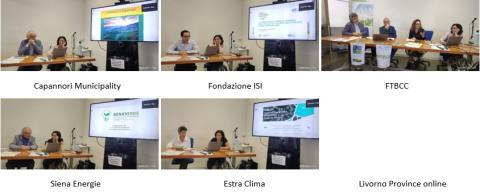Synergies between EU projects: 𝐑𝐄𝐂𝟒𝐄𝐔-𝐈𝐍𝐕𝐄𝐂𝐄 (3)
6 examples of RECs
Presentation of 6 examples of RECs established or in the process of being established, differentiated based on the promoter and representing different prototypes already present in the area:
- REC promoted by a public body:
1) Capannori Municipality – Giampiero Tartagni (REC president)
(link here)
2) Livorno Province – Michela Chiti (European Planning and Policies Service)
(link here) - REC promoted by companies: ISI Foundation, coordinator of the Unioncamere Toscana Energy Transition project with which they supported the development of 4 RECs – Simone Coltella
(link here) - REC promoted by cooperative: Sievenergie – Silvia Russo (FTBCC)
(link here) - REC promoted by associations: Sienaenergia – Alessandro Vigni (REC president)
(link here) - REC promoted by a third party producer: Estra Clima – Elena Beudò
(link here)
Interesting aspects
Several interesting aspects emerged from the above presentations and the following round table:
- the collaboration between Sienaenergie and the University of Siena on a shared energy management system to signal to citizens when, for example, it’s the right time to turn on the washing machine in the presence of shared and available energy or even have it started by home automation,
- CEBASE's collaboration with installation companies to encourage the entry of new members thanks to the information and awareness that these companies can provide,
- the availability of the Scuola Superiore Sant'Anna (Department of Sociology) to provide a contribution through active participation in the INVECE project for all aspects that may concern the sociological issues relating to RECs (e.g. energy poverty),
- the difficulty in involving Municipalities if the initiative starts from citizens, associations, businesses, more generally difficulty in convincing subjects to participate in a REC,
- the need to have legal, commercial, technical support, etc. for the development of the project of a REC and/or plants to be proposed to the Municipalities with PPP,
- the need to harmonize and make compatible the various relief measures (energy account incentives and non-refundable contributions: for instance the uncertainty regarding the cumulation between the GSE incentive and the tax credit from Transition 5.0), considering the difficulty for the REC, which has limited capacity to attract financial resources, to find financing to build plants,
- the complexity of connecting the systems to the network despite the network manager (e-distribution) having given prior approval,
- the influence that plans, programs, regulations and acts governing the development of RES at a local level (guidelines for the integration of plants into landscapes, compatibility with intended uses, urban planning regulations, structural plans, etc.) have on the process of authorization, but also in the identification of the procedure to be followed and the related timings.
Critical issues
One of the main critical issues that emerged is the relationship with the GSE, in particular in the phase that follows the construction of the plants and the registration on the REC portal to obtain the incentive.
- First of all, the difficulty in communicating and finding the reference person who can respond comprehensively to requests for clarification and in REC registration and data entry on the GSE portal; and furthermore:
- when introducing the statute into the portal, the GSE rejects it if it does not contain exactly what is written in the Cacer decree, only in this way it can be approved,
- bureaucratic repetition of the documents to be attached for each configuration,
- exclusion of the participation of condominiums,
- the edit and add function is not active on the GSE portal to insert new members of the REC and new plants (in this regard, the GSE responded via ARRR that their experts are working on the implementation of the function!!).
Conclusions
In conclusion, David Tei, in thanking all the participants to the morning session and those who were connected online for their participation, and considering the morning very fruitful, suggests structuring this working group who can make reference to the Tuscany Region on the various topics addressed during present the meeting and believes it will be useful to organize other moments meeting in order to highlight critical issues and good practices.
The next appointment could be in mid-December/January (date to be defined) in Florence for the launch event of the REC Observatory. Stay tuned!
Click here for the article in Italian language
Download the Report text in pdf


